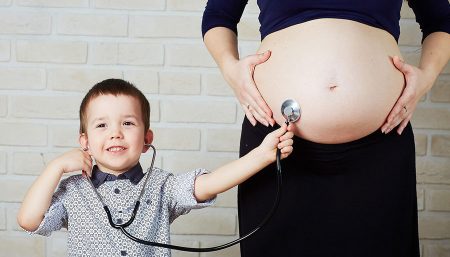
An ectopic pregnancy (also called a tubal pregnancy) occurs when a fertilized egg is implanted outside the uterus, typically in one of the Fallopian tubes. Sometimes the embryo can also occur in the cervical canal, one of the ovaries or the pelvic or abdominal cavity (abdominal pregnancy).
Once conception occurs, the fertilized egg usually takes about four to five days to travel down the tube from the ovary to the uterus. If the tube is damaged or blocked, or fails to propel the egg toward the uterus, the egg may become implanted in the wall of the tube and continue to develop there. Occasionally it may implant in another part of the abdomen, in an ovary, or in the cervix. If an ectopic pregnancy is not recognized and treated in time, the embryo will grow until it causes the tube to rupture, resulting in severe abdominal pain, bleeding, and sometimes even death.
- Pelvic inflammatory disease (PID), gonorrhea, or chlamydia (which may be symptomless) – Rate of ectopic pregnancy in women with previous known PID is increased 6-10 times higher than in women with no previous history of PID. A published study of 745 women with one or more episodes of PID that attempted to conceive showed that 16% were infertile from tubal occlusion. Of those that conceived, 6.4% had ectopic pregnancies.
- You’ve had a previous ectopic pregnancy
- You have an intrauterine device (IUD) in place when you get pregnant. (IUDs are about 99 percent effective at preventing pregnancy, but if you do get pregnant while using one, the pregnancy is likely to be ectopic. Having used an IUD in the past will not increase your risk for ectopic pregnancy.)
- Your tubes were damaged by a previous infection or surgery.
- You’re being evaluated or treated for infertility. (Infertility is often caused by damaged tubes, and if you get pregnant while being treated for infertility, there’s a higher than average chance that the pregnancy will be ectopic.)
- You’ve had previous pelvic or abdominal surgery, such as the removal of an ovarian cyst or fibroids, an appendectomy, or a cesarean section.
- A few studies suggest you may also have a slightly increased risk for ectopic pregnancy if you smoke cigarettes or douche regularly.
Ectopic pregnancies are most commonly discovered at six or seven weeks but may be found as early as four weeks.
Common symptoms of ectopic pregnancy are sharp abdominal cramps or pains on one side. The pains may start out as a dull ache that gets more severe with time. Neck pains and shoulder pains are also common. While cramping and bleeding can mean many things, pain in the shoulder, particularly when you lie down, is specifically characteristic of a ruptured ectopic pregnancy. The pain is caused by internal bleeding that irritates nerves that happen to go to the shoulders, but may not be felt in all cases. You may also have a menstrual type of bleeding along with the pain, but the pain is the most obvious sign.
If the ectopic is ruptured, you may also have signs of shock like a weak, racing pulse; pale, clammy skin; and dizziness or fainting. You’ll need to get medical attention right away.
Ectopic pregnancy can be tricky to diagnose. If a woman tests positive for pregnancy ( hCG levels test ), or has missed her period but the uterus does not display the typical signs associated with pregnancy, an ectopic pregnancy is suspected. An ultrasound scan can be useful in identifying that the uterus is indeed empty and that blood has accumulated in the pelvic or abdominal cavity. A culdocentesis may also be then performed to confirm a diagnosis of an ectopic pregnancy. A laparoscope may also be employed to directly view the ectopic pregnancy.
If the pregnancy is clearly ectopic and the embryo is still relatively small, you may be given the drug methotrexate. This is the best way to terminate the pregnancy without damaging your tube. The drug is injected into a muscle and reaches the embryo through your bloodstream, killing the cells that are building the placenta and causing the embryo to be reabsorbed into your body, as it would be if you had a miscarriage. You may feel some cramping during this process as the embryo swells. You may bleed for a week or two afterward as you shed the lining of your uterus, which should feel like a regular menstrual period. You’ll need to come back in for blood testing to make sure that the pregnancy has really been terminated.
If the embryo is too large for methotrexate to be used or you’re in severe pain or bleeding internally, you’ll need surgery. The possible procedures for ectopic pregnancy can all be done by laparoscopy (same day surgery) or by laparotomy (bigger incision).

Different Procedures used:
- Salpingotomy (or -ostomy): Making an incision on the tube and removing the pregnancy.
- Salpingectomy: Cutting the tube out.
- Segmental resection: Cutting out the affected portion of the tube.
- Fimbrial expression: “Milking” the pregnancy out the end of the tube.
In general, the procedure of choice will be salpingectomy if future fertility is of no concern, if the tube is ruptured, if there is significant anatomic distortion, or if there is overt hemorrhage.
Abdominal Surgery- In this case, you’ll be given general anesthesia and a surgeon will open your abdomen and remove the embryo as well as the ruptured tube, if necessary. You may need a blood transfusion to replace lost blood if you were bleeding heavily before surgery. Afterward, you’ll need about six weeks to recuperate. You may feel bloated, and have sore breasts and abdominal pain or discomfort as you heal.
Overall, your chances of having another ectopic pregnancy are about 10 percent, depending on what caused the first one and what type of treatment you had. That means that your chances of having a normal pregnancy next time are still very high — at least 90 percent. If your first ectopic pregnancy was the result of damage to the tube from an infection, tubal ligation, or DES exposure, there’s a greater chance that the other tube is damaged as well.
Disclaimer
The Content is not intended to be a substitute for professional medical advice, diagnosis, or treatment. Always seek the advice of your physician or other qualified health provider with any questions you may have regarding a medical condition.



